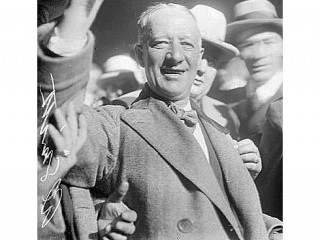
Alfred E. Smith biography
Date of birth : 1873-12-30
Date of death : 1944-10-04
Birthplace : New York City, New York, USA
Nationality : Australian
Category : Politics
Last modified : 2010-11-21
Credited as : Politician, former Governor of New York,
Alfred Emmanuel Smith, American politician, was governor of New York. His race as presidential candidate in 1928 was important as a test of urban influence in American politics.
Alfred "Al" E. Smith was born on Dec. 30, 1873, in a tenement on New York City's Lower East Side. He attended St. James's Parochial School until, at the age of 15, he began supporting his widowed mother and sister by working in a fish market. Like other ambitious Irish-Catholic youths of the day, Smith gravitated toward the Tammany Hall political organization, working initially as a subpoena server. As a reward for faithful service, he was picked to run for the New York State Assembly in 1903.
Smith's career in the Assembly represented the politics of the ghetto, combining pragmatic reform with service to the machine. In 1911 he was appointed chairman of the important Ways and Means Committee as well as vice-chairman of the Factory Investigating Commission. This gave him the opportunity to familiarize himself with industrial conditions. He introduced several reform measures representative of the kind of bread-and-butter progressivism that immigrants in New York's ghettos needed. In 1912 he became House floor leader, and the next year the Democrats acknowledged his influence by electing him Speaker.
At the constitutional convention in 1915 Smith demonstrated that he was the best-informed man on the business of the state of New York, and Tammany leaders immediately designated him sheriff of New York County. In 1917 Smith became president of the Board of Aldermen. The following year, upstate delegates to the Democratic convention successfully backed his candidacy for the governorship. To the surprise of many political observers, Smith defeated the Republican incumbent.
Governor Smith, the spokesman for the new urban masses, instituted a number of important social reforms, including an amended workmen's compensation law, higher teachers' salaries, and appropriations for the sick and mentally ill. He also urged the legislature to extend labor laws to protect women in industry and to enact health insurance legislation. His growing popularity was shown in 1920, when a spontaneous parade erupted after his name was placed before the Democratic National Convention for the presidency. His bid for reelection as governor was defeated, however, in the Republican landslide of 1920, but 2 years later he was again elected. In the spring of 1924 he declared his presidential candidacy.
Smith's candidacy was backed by the urban wing of the Democratic party. The rural wing supported William Gibbs McAdoo. The two-thirds requirement for nomination canceled out Smith and McAdoo, and after a bitter clash the delegates chose John W. Davis on the 103d ballot.
At Davis's behest, Smith again ran for the governorship, defeating Lt. Col. Theodore Roosevelt by 108,000 votes. During his third term Smith continued the fight for Progressive legislation, campaigning for government developed waterpower sites and for administrative reorganization. He won an unprecedented fourth term in 1926.
Smith's presidential nomination in 1928 on the first ballot illustrated the growing power of urban Democrats, but he had little chance of winning against Republican prosperity. He compounded his difficulties by making no effort to unite the factions of his party. His unwillingness or inability to establish a Progressive position that differed sharply from that of his opponent, Herbert Hoover, permitted the campaign to focus on prohibition, personalities, and particularly on Smith's Catholicism. Although soundly defeated, Smith had brought so many foreign-born Americans to the polls that the Democratic party, for the first time, carried the big cities.
In the aftermath of defeat, Smith became increasingly a spokesman and defender of the business community. Beginning in 1933, he condemned the social philosophy and domestic policies of President Franklin Roosevelt. He became in 1934 a charter member of the American Liberty League, an organization of wealthy, conservative industrialists and politicians opposed to the New Deal. Eventually Smith broke with the Democratic party.
Despite an apparent ideological turnabout, Smith's actions were consistent. He was fundamentally conservative, possessing an exaggerated reverence for the institutions and traditions of American society. He had never questioned the assumptions of capitalism and found the notion of a planned society repugnant. If he seemed to have changed in the 1930s, it was only because the times themselves had changed but he had not. He died in New York City on Oct. 4, 1944.
Smith's own account is Up to Now: An Autobiography (1929). A recent and probably definitive biography, which makes use of papers of Frances Perkins that have not been accessible to other biographers, is Matthew and Hannah Josephson, Al Smith: Hero of the Cities (1969). Also recent and well documented is the lively account by Richard O'Connor, The First Hurrah: A Biography of Alfred E. Smith (1970). Oscar Handlin, Al Smith and His America (1958), places Smith in the context of his time.
Eldot, Paula, Governor Alfred E. Smith: the politician as reformer, New York: Garland, 1983.
Handlin, Oscar, Al Smith and his America, Boston: Northeastern University Press, 1987, 1958.
















